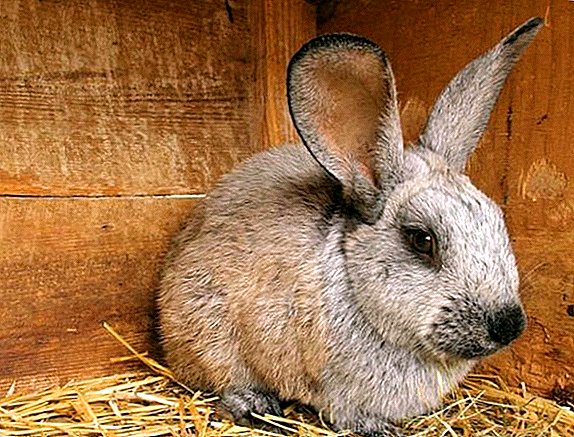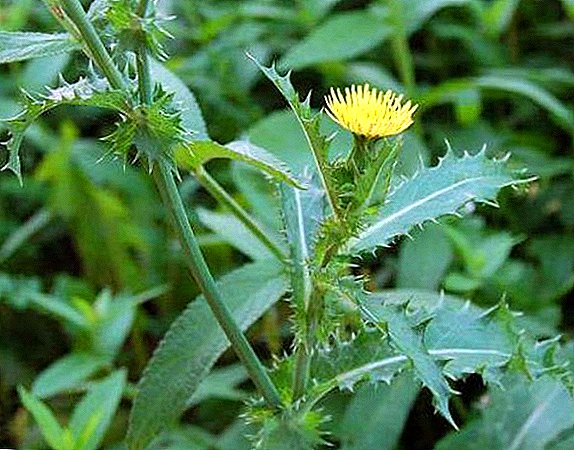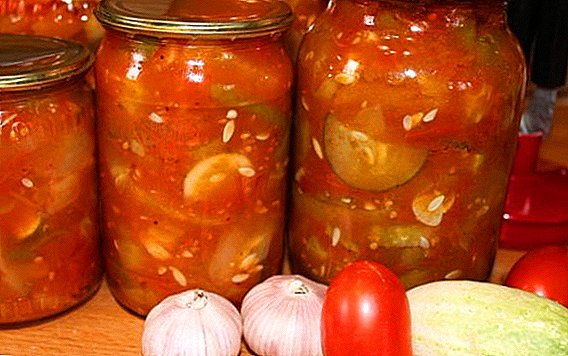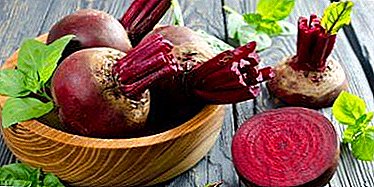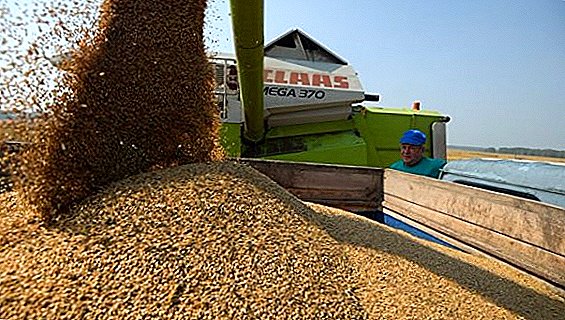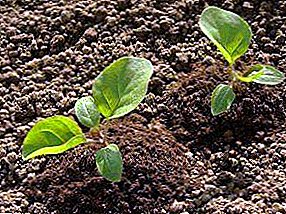
Transplantation in the open ground of carefully grown seedlings is a crucial moment for any gardener.
With a properly carried out procedure, plants do not slow down growth, flowering and the formation of ovaries occur exactly on time.
To transplant successfully, it is important to choose the right time, prepare the soil, do not forget about watering and tying.
Transplanting to a greenhouse or garden bed: when to do it
 For successful growth of eggplants, it is important to choose the right transplant time. Eggplant is very thermophilic, the soil should warm up to 12-13 degrees. Typically, the temperature of the soil reaches in the second half of May. In accordance with national signs, the season of mass flowering of dandelions will be an ideal time for transplanting eggplants to garden beds and to cold greenhouses.
For successful growth of eggplants, it is important to choose the right transplant time. Eggplant is very thermophilic, the soil should warm up to 12-13 degrees. Typically, the temperature of the soil reaches in the second half of May. In accordance with national signs, the season of mass flowering of dandelions will be an ideal time for transplanting eggplants to garden beds and to cold greenhouses.
If the cold spring is prolonged, the soil heating process can be accelerated, Covering the beds with a double layer of polyethylene film or an opaque nonwoven fabric. When moving plants in open ground, you can take more drastic measures by building a temporary shelter over the beds. Arcs of strong wire are stuck into the ground, over which plastic film is stretched. In such an improvised greenhouse, seedlings feel comfortable and are not afraid of sudden frosts. In heated greenhouses seedlings can be planted year-round.
Most varieties are ready to transplant. at the age of 20-25 days after emergence. In accordance with this, the time of sowing seeds is calculated. If you plan to grow eggplant in the open field, they are sown on seedlings in the second half of April and transplanted in early June. For planting under the film, seeds are sown at the end of March and early April, moving young plants to the beds of May 10-15. For film and glazed greenhouses, seedlings are grown from the end of March, and on April 15 she is ready to move to a permanent place of residence.
Choosing the time of disembarkation, it is necessary to take into account the variety of eggplants. For better fruiting Some hybrids are recommended to be planted later than the specified dates for 5-10 days. Older seedlings take root better and form the ovary more quickly. It is necessary to focus on the appearance of young plants. Ideal seedlings are strong, with thick succulent stems and bright, not drooping greens. It is desirable to have 4-5 of these sheets.
Stalks should not be too stretched. If transplanting to beds is delayed, it is recommended to treat seedlings in containers with special drugs that slow down growth. Suitable light compounds Camposan or TUR, safe for plants. The preparations do not slow down the laying of buds and the formation of ovaries, the stalks of eggplants become more robust, the appearance of seedlings improves.
Soil preparation
 Before moving seedlings soil needs to be prepared. Hcringing loosely, the remains of plants and small garbage are selected from it. A portion of humus or peat is added to the ground. The lighter the soil, the higher the yield of eggplant. In the greenhouse it is recommended to annually update the top layer of soil. For greater safety, it can be shed with a solution of potassium permanganate. It is desirable to use the same land that was used for growing seedlings, the adaptation of young plants will be more successful.
Before moving seedlings soil needs to be prepared. Hcringing loosely, the remains of plants and small garbage are selected from it. A portion of humus or peat is added to the ground. The lighter the soil, the higher the yield of eggplant. In the greenhouse it is recommended to annually update the top layer of soil. For greater safety, it can be shed with a solution of potassium permanganate. It is desirable to use the same land that was used for growing seedlings, the adaptation of young plants will be more successful.
The wells are best prepared before planting. In each make portions of rotted manure and sprinkle it with a light layer of peat. It’s good to spill the wells with hot water and let them cool. The distance between the bushes varies from 40 to 50 cm and depends on the type of eggplant. More compact plants can be planted denser. Mandatory between rows of a width of at least 70 cm.
Eggplant Transplant: Step-by-Step Actions
 Transplanting young plants better to spend in the morning, in warm sunny weather.
Transplanting young plants better to spend in the morning, in warm sunny weather.
- Eggplant seedlings are gently turned over.. Pull the stems can not be saplings fragile and easily injured. The plant is extracted together in a clod of earth, covered with roots. Shake the ground is not necessary. Seedlings grown in peat pots or tablets cannot be removed from their containers.
- Sapling moves in the hole. The depth must correspond to the earth coma, it is undesirable to mix roots. The seedling is deepened to the cotyledon leaves, the surface of the earthen coma is covered with fresh soil for 2-3 cm. It is impossible to dig in the plants too deeply, this can provoke the appearance of a black leg. Leaving the roots on the surface is also not worth it.
- The soil around the plant is carefully crimped hands. It is impossible to tamp it tightly, but do not allow further soil erosion. Each seedling is watered with warm distilled water (at least 1-2 liters).
- Top soil is mulched. You can use humus, peat or straw. But a whiter option is to cover the ground with a dark, opaque film or other opaque non-woven material in which the holes for the plants are cut. Such a shelter will protect the eggplant from a sudden drop in temperature, reduce the time of adaptation and save it from weeds.
Planting Eggplant Seeds: Preparing the Material
 You can do without growing seedlings at home, sowing eggplant seeds directly into the ground. Seeds pre-moving, empty and warped are rejected. Some gardeners prefer to sow the seeds dry, considering that the newly emerged sprouts are easily injured. Others soak the seed in a small amount of warm water or wrap them in a damp cloth for swelling. The choice of method depends on the eggplant variety and personal preferences.
You can do without growing seedlings at home, sowing eggplant seeds directly into the ground. Seeds pre-moving, empty and warped are rejected. Some gardeners prefer to sow the seeds dry, considering that the newly emerged sprouts are easily injured. Others soak the seed in a small amount of warm water or wrap them in a damp cloth for swelling. The choice of method depends on the eggplant variety and personal preferences.
Before sowing on open beds seeds can be hardened. They are wrapped in a damp cloth, waiting for the sprouts to appear, and then seed is sent to the lower chamber of the refrigerator for a day. This procedure enhances the immunity of plants, making them immune to adverse weather conditions.
Another tried and tested method - seed warming. It takes place at a temperature of 60 degrees, lasts about 2 hours. Then seed for 12 hours is placed in an aqueous solution of manganese sulphate, potassium nitrate and superphosphate.
Read more about seed preparation before sowing.
Sowing in the ground: step by step instructions
 Plant seeds with eggplants better in the second half of May and early June.
Plant seeds with eggplants better in the second half of May and early June.
- The beds are prepared, cleared of debris and fertilized with a generous portion of humus.
- The soil needs to be well loosened. and make furrows 5-7 cm deep.
- In them seeds are sown at a distance of 10-20 cm. The distance depends on the variety, usually more accurate data are indicated on the seed packaging.
reference! Early ripening eggplants can be planted more densely, late ripening need free space.
Another option is possible.
- In the ground holes are made, same, as well as at disembarkation of seedling.
- The distance between the holes is about 20 cm, between rows - at least 40 cm. A little rotted manure is laid out in each well and sprinkled with a layer of peat.
- 4-5 seeds are sown.
This option is useful when growing on the trellis.
Furrows or holes watered with warm, settled water from a watering can. Then they are powdered with soil and easily tamped with palms. Stand substrate should be very thin, not more than 1 cm. Some gardeners prefer not to fall asleep the seeds, leaving them on the surface. In this case, the surface of the soil with crops is covered with a film or glass. Landings can be warmed, covered with straw mats.
After 10 days, after emergence, plantings are thinned. Weak sprouts are removed: cut with a knife or pinch. You can not pull them out, it can injure the roots of strong seedlings.
After thinning young plants need to feed, watering them with an aqueous solution of slurry or diluted bird droppings. After fertilizer planting plentifully watered with clean water. She also washed the dressing that accidentally fell on the leaves. This will help avoid burns.
Useful materials
Read other articles about growing and caring for eggplant seedlings:
- Different methods of cultivation: in peat tablets, in a snail and even on toilet paper.
- All features of sowing according to the lunar calendar.
- Golden rules for growing from seed.
- Features of cultivation in different regions of Russia: in the Urals, in Siberia and the Moscow region.
- When is the best time to sow seeds?
Properly transplanted eggplants should quickly start growing, actively planting flower buds. Improved adaptation will help timely feeding, proper watering, protection of plants from the weather and insect pests.


